Related Research Articles
The Dominion Land Survey is the method used to divide most of Western Canada into one-square-mile (2.6 km2) sections for agricultural and other purposes. It is based on the layout of the Public Land Survey System used in the United States, but has several differences. The DLS is the dominant survey method in the Prairie provinces, and it is also used in British Columbia along the Railway Belt, and in the Peace River Block in the northeast of the province.

The Yellowhead Highway is a major interprovincial highway in Western Canada that runs from Winnipeg to Graham Island off the coast of British Columbia via Saskatoon and Edmonton. It stretches across the four western Canadian provinces of British Columbia, Alberta, Saskatchewan, and Manitoba and is part of the Trans-Canada Highway system and the larger National Highway System, but should not be confused with the more southerly, originally-designated Trans-Canada Highway. The highway was officially opened in 1970. Beginning in 1990, the green and white Trans-Canada logo is used to designate the roadway.

The Grand Trunk Railway was a railway system that operated in the Canadian provinces of Quebec and Ontario and in the American states of Connecticut, Maine, Michigan, Massachusetts, New Hampshire, and Vermont. The railway was operated from headquarters in Montreal, Quebec, with corporate headquarters in London, United Kingdom. It cost an estimated $160 million to build. The Grand Trunk, its subsidiaries, and the Canadian Government Railways were precursors of today's Canadian National Railway.
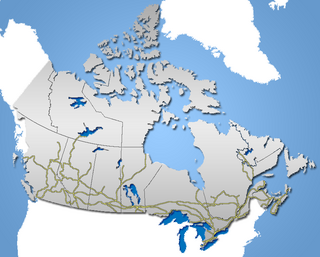
Canada has a large and well-developed railway system that primarily transports freight. There are two major publicly traded transcontinental freight railway systems, Canadian National (CN) and Canadian Pacific Kansas City (CPKC). Nationwide passenger services are provided by the federal crown corporation Via Rail, and three international services to the US by Amtrak. Three Canadian cities have commuter train services: in the Montreal area by Exo, in the Toronto area by GO Transit, and in the Vancouver area by West Coast Express. These cities and several others are also served by light rail or metro systems. Only one (Toronto) has an extensive streetcar (tram) system. Smaller railways such as Ontario Northland Railway also run passenger trains to remote rural areas. The Rocky Mountaineer and Royal Canadian Pacific provide luxury rail tours for viewing scenery in the Canadian Rockies as well as other mountainous areas of British Columbia and Alberta.

The Grand Trunk Pacific Railway was a historic Canadian transcontinental railway running from Fort William, Ontario to Prince Rupert, British Columbia, a Pacific coast port. East of Winnipeg the line continued as the National Transcontinental Railway (NTR), running across northern Ontario and Quebec, crossing the St. Lawrence River at Quebec City and ending at Moncton, New Brunswick. The Grand Trunk Railway (GTR) managed and operated the entire line.
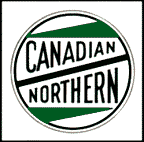
The Canadian Northern Railway (CNoR) was a historic Canadian transcontinental railway. At its 1923 merger into the Canadian National Railway, the CNoR owned a main line between Quebec City and Vancouver via Ottawa, Winnipeg, and Edmonton.
The history of rail transport in Canada began in the early 19th century. The Canadian railway system saw several expansion "booms" throughout history, as well as a major change from broad to standard gauge which occurred in the 1870s. An initially disconnected system was gradually integrated with the American railway network, as Canadian and American railway companies built lines and bought smaller companies in each other's country. The Intercolonial Railway, a product of Canadian Confederation, was Canada's first major experiment in railway nationalization, and following Confederation, several transcontinental railways were built.
Alberta Provincial Highway No. 16, commonly referred to as Highway 16, is a major east–west highway in central Alberta, Canada, connecting Jasper to Lloydminster via Edmonton. It forms a portion of the Yellowhead Highway, a major interprovincial route of the Trans-Canada Highway system that stretches from Masset, British Columbia, to Portage la Prairie, Manitoba, near Winnipeg. Highway 16 spans approximately 634 km (394 mi) from Alberta's border with British Columbia in the west to its border with Saskatchewan in the east. As of 2010, all but less than 96 km (60 mi) of the route was divided, with a minimum of two lanes in each direction. It is designated a core route in Canada's National Highway System.
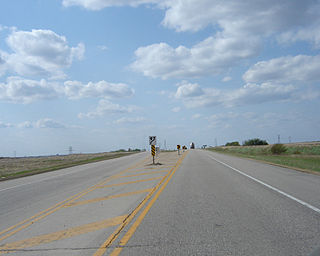
Highway 16 is a provincial highway in the Canadian province of Saskatchewan. It is the Saskatchewan section of the Yellowhead Highway, and also the Trans-Canada Highway Yellowhead section. The main purpose of this highway is to connect Saskatchewan with Canadian cities such as Edmonton and Winnipeg. The highway runs from the Alberta boundary in Lloydminster to the Manitoba boundary near Marchwell. Major cities it passes through are Saskatoon, North Battleford in the central part of the province, Yorkton in the far east and Lloydminster to the far west.
Semans is a village in the Canadian province of Saskatchewan within the Rural Municipality of Mount Hope No. 279 and Census Division No. 10. The village is located approximately 125 km north of the City of Regina and 195 km southeast of the City of Saskatoon.
Canadian National Hotels was a hotel chain under control by Canadian National Railways. In addition to their own hotels, it acquired some from predecessor railway companies like the Grand Trunk Pacific Railway, Grand Trunk Railway and Ottawa, Arnprior and Parry Sound Railway. Some of their assets were later acquired by rival Canadian Pacific Hotels after 1988.

The Biggar station is a heritage railway station operated by Via Rail located in Biggar, Saskatchewan, Canada.
Highway 49 and Provincial Trunk Highway 49 is a highway in the east central portion of the Canadian province of Saskatchewan and a very short highway in the province of Manitoba. It runs from Saskatchewan Highway 35 between the communities of Fosston and Hendon to the Saskatchewan – Manitoba border, before ending at Provincial Trunk Highway 83 south of the community of Benito. The combined highway is about 166.4 km (103.4 mi) in length, 165.2 km (102.7 mi) is in Saskatchewan and 1.2 km (0.7 mi) is in Manitoba.

Charles May was Canadian contractor and politician. He served on the Edmonton City Council and later as Mayor of Edmonton from 1905 to 1906.
Xena, Saskatchewan was a village in Saskatchewan. The last building was demolished in the 1970s. It is now an unincorporated area in the rural municipality of Morris No. 312, in the Canadian province of Saskatchewan. Xena is located on Highway 2 in central Saskatchewan.
Transport in Saskatchewan includes an infrastructure system of roads, highways, freeways, airports, ferries, pipelines, trails, waterways, and railway systems serving a population of approximately 1,098,352 inhabitants year-round.
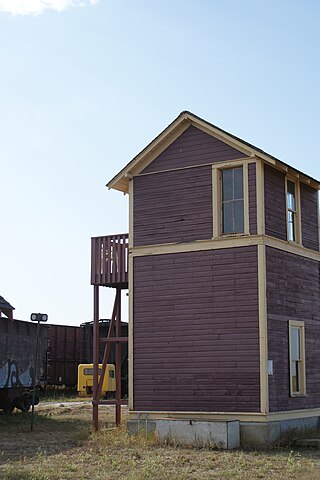
Oban is an unincorporated area administered by the rural municipality of Biggar No. 347, in the Canadian province of Saskatchewan. Oban is located on Saskatchewan Highway 14 in western Saskatchewan. The closest town is Biggar to the southeast. Biggar railway station is a divisional point for the Canadian National Railway (CNR). Oban had the last provincial interlocking tower at the Canadian National Railway and Canadian Pacific Railway level crossing, which was constructed in 1910 and closed in 1990.
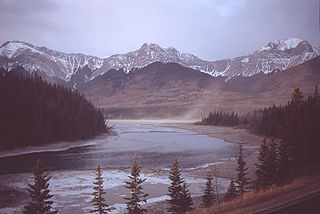
The Nikanassin Formation is a stratigraphic unit of Late Jurassic (Portlandian) to Early Cretaceous (Barremian) age. It is present along the western edge of the Western Canada Sedimentary Basin in western Alberta and northeastern British Columbia. Its name was first proposed by D.B. Dowling in 1909 (Coal Fields South of Grand Trunk Pacific Railway, in the foothills of the Rocky Mountain, Alberta Page 140 paragraph 4 " to this it is proposed to give the name Nikanassin, from the Cree word meaning outer range" Also it is noted on the map by D.B. Dowling.(Geological Survey of Canada. Incorrect info follows: It was named by B.R. MacKay in 1929 for the Nikanassin Range of the front-central ranges of the Canadian Rockies. Mackay did not designate a type locality for the formation, although he described outcrops near the hamlet of Brûlé, north of the Yellowhead Highway outside of Jasper National Park.
Winter is an unincorporated locality in Senlac Rural Municipality No. 411, Saskatchewan, Canada. It is located on Highway 787 & 675, 50 km northwest of Unity, the nearest town. It is 15 km North of Rutland and 35 km South of Neilburg. Winter is located at Mile 77.3 on the Canadian National Railway. The community gets its name from Mr. O. Winter, who was a contractor for the Grand Trunk Pacific Railway. Mr. Winter named the siding after himself. This line was named alphabetically, from the east "Vera", after Winter's daughter, and to the west "Yonker", named after his mother's family. Winter had a store with post office, an elevator, a GTPR station, a lumber yard and a school that closed in 1968. Winter community well was said to have soft water.
Yonker is an unincorporated locality in Senlac Rural Municipality No. 411, Saskatchewan, Canada. It is located about 42 km east of Chauvin, Alberta. Yonker is located along the Canadian National Railway. The community gets its name from Mr. O. Winter, who was a contractor for the Grand Trunk Pacific Railway. This line was named alphabetically, from the east, "Vera", after his daughter, "Winter" after himself; and to the west "Yonker", named after his mother's family.
References
- 1 2 Todd, John (September 1976). "The Grand Trunk Pacific's Lake Superior Branch" (PDF). Canadian Rail. Canadian Railroad Historical Association (296). ISSN 0008-4875.